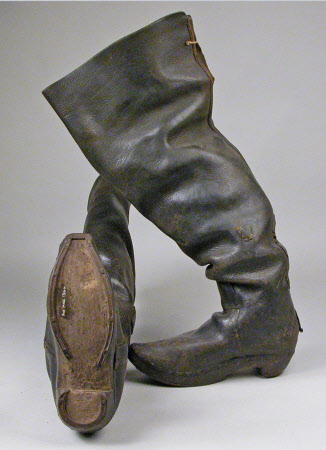Boot
Category
Leatherwork
Date
1650 - 1700
Materials
Leather, wood and iron
Measurements
650 mm (L)
Order this imageCollection
Rufford Old Hall, Lancashire
NT 784530.1
Caption
In the 17th century Britain was an agricultural country. Leather was the material of choice for a farmer working outdoors in all weathers. Strong and durable breeches, boots and jerkins, made of oiled or waxed tanned cattle hide, offered protection. Although they were not entirely waterproof, they could withstand wet conditions (the area around Rufford in Lancashire was then largely wetland) and retain their form. These working boots – made of tough, thick leather and stitched with waxed hemp – have a reinforced seam at the back and show signs of heavy wear, including patched repair. The uppers are attached to wooden clog soles reinforced with iron around the toe and heel. Designed to extend above the knee, the boots would be suitable for jobs involving wading in water, such as ditch digging. Because shoes and boots were essential items of clothing, most communities of any size included a shoemaker or ‘cordwainer’ (cobblers at this time being confined to repair work). These highly skilled artisans produced around 100,000 boots across Britain each year.
Summary
One of a pair of gentleman's leather boots, Cromwellian style, wooden soles with iron reinforcements.
References
Antrobus and Slocombe 2025: Helen Antrobus and Emma Slocombe, 100 Things to Wear: Fashion from the collections of the National Trust, National Trust 2025, p. 45.
